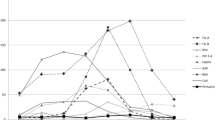Abstract
Nasopharyngeal aspirate (NPA) Bordetella pertussis-specific IgA antibody assay using whole-cell (WC) antigen has previously been shown to have promise in the diagnosis of patients with suspected pertussis. Recently, the use of WC assays in serum have been replaced by pertussis toxin (PT) because of specificity concerns. In this study, PT and WC B. pertussis-specific IgA antibody was assayed in 491 NPAs. Specimens also had molecular testing for the presence of B. pertussis and B. parapertussis as per the usual laboratory protocol. Positive concordance of the two serological assays was 51.2%, negative concordance was 67.5% and total concordance was 75.8%. 99 of 119 discordant specimens were resolved by utilising the B. pertussis polymerase chain reaction (PCR) result and clinical status, and yielded a sensitivity of 57.6% and a specificity 97.7% for WC, with 90.2% and 93.1%, respectively, for the PT assay (p < 0.00025 and 0.025–0.01). In contrast, the sensitivity of PCR was only 19.1% in this cohort. We conclude that specificity is not a significant issue for mucosal pertussis-specific IgA assays using WC, but the superior sensitivity of the PT assay favours the latter method. This assay, combined with PCR assays, should significantly improve the diagnosis of pertussis cases.
Similar content being viewed by others
References
Beaman MH, Karimi M, Hodge M, Keil AD, Campbell P (2014) Diagnosis of pertussis using nasopharyngeal IgA and polymerase chain reaction in specimens from outpatients in Australia. Eur J Microbiol Immunol 4:177–183
Hallander HO, Reizenstein E, Renemar B, Rasmuson G, Mardin L, Olin P (1993) Comparison of nasopharyngeal aspirates with swabs for culture of Bordetella pertussis. J Clin Microbiol 31:50–52
Pianciola L, Mazzeo M, Flores D, Hozbor D (2010) Optimización del procesamiento y la conservación de muestras clínicas destinadas al diagnóstico molecular de coqueluche. [Optimization of processing and storage of clinical samples to be used for the molecular diagnosis of pertussis]. Rev Argent Microbiol 42:108–113
Birkebaek NH, Kristiansen M, Seefeldt T, Degn J, Moller A, Heron I, Andersen PL, Moller JK, Ostergård L (1999) Bordetella pertussis and chronic cough in adults. Clin Infect Dis 29:1239–1242
Guiso N, Berbers G, Fry NK, He Q, Riffelmann M, Wirsing von König CH; EU Pertstrain group (2011) What to do and what not to do in serological diagnosis of pertussis: recommendations from EU reference laboratories. Eur J Clin Microbiol Infect Dis 30:307–312
Dawson-Saunders B, Trapp RG (1990) Basic and clinical statistics. Appleton and Lange, San Mateo
Australian Government Department of Health and Ageing (2014) Pertussis case definition. Surveillance case definitions for the Australian National Notifiable Diseases Surveillance System. Available online at: http://www.health.gov.au/internet/main/publishing.nsf/Content/cda-surveil-nndss-casedefs-cd_pertus.htm. Accessed 30 Nov 2015
Palmer CM, McCall B, Jarvinen K, Nissen MD (2007) Bordetella pertussis PCR positivity, following onset of illness in children under 5 years of age. Commun Dis Intell Q Rep 31:202–205
Acknowledgements
We would like to thank our microbiological colleagues at WDP (Drs. D. McLellan, D. Chih and S. Perera) and the Information Technology Department of Western Diagnostic Pathology for their assistance in gathering these data.
Author information
Authors and Affiliations
Corresponding author
Ethics declarations
Further ethical approval not required. This study was part of regular assay development in a routine clinical laboratory subject to regular accreditation oversight. Samples were collected with informed consent as part of routine clinical management.
Funding
Nil.
Conflict of interest
Nil.
Rights and permissions
About this article
Cite this article
Norman, D., Karimi, M., Herbert, A. et al. Nasopharyngeal pertussis toxin IgA antibodies in the diagnosis of pertussis in Australian community patients. Eur J Clin Microbiol Infect Dis 36, 2259–2261 (2017). https://doi.org/10.1007/s10096-017-3057-x
Received:
Accepted:
Published:
Issue Date:
DOI: https://doi.org/10.1007/s10096-017-3057-x




